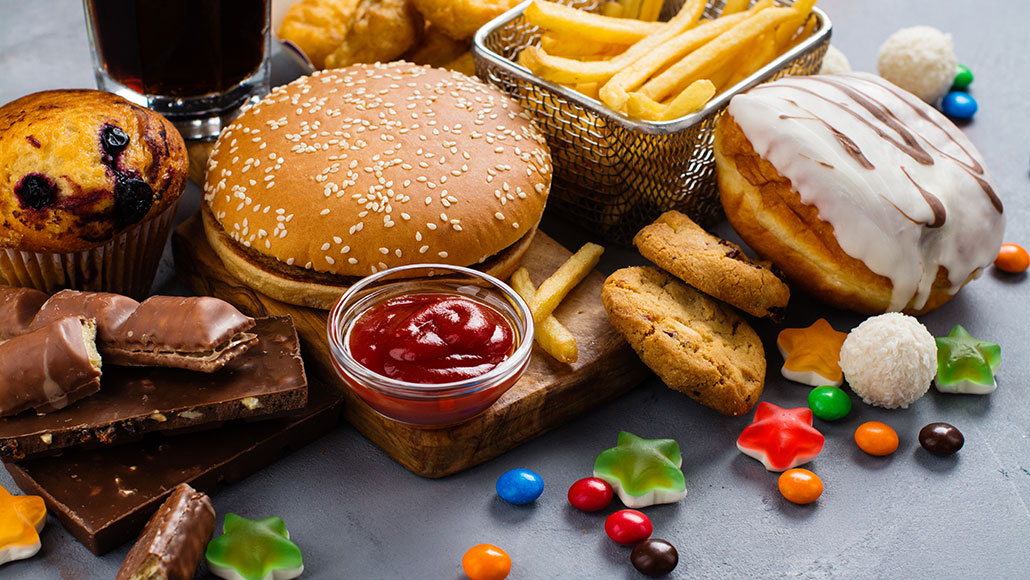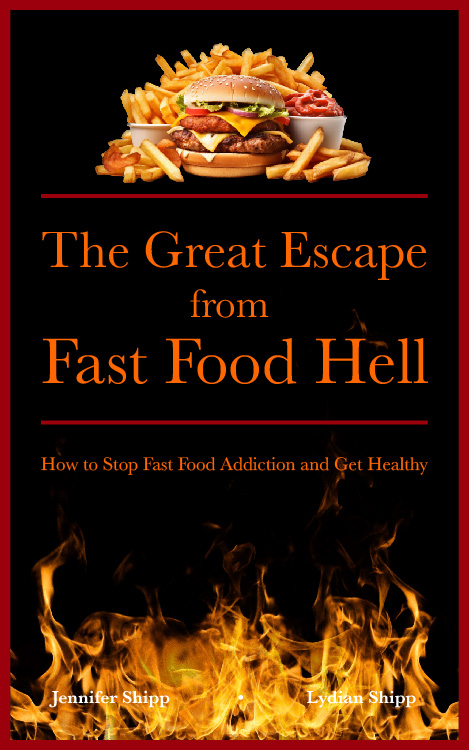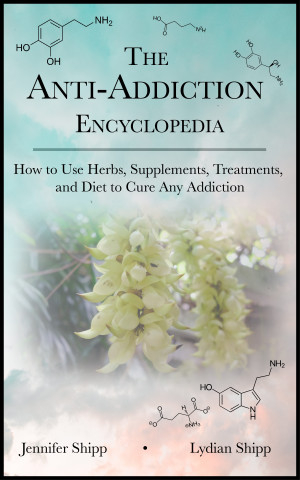 The Toxic and Addictive Ingredients "Hiding" in Fast Food
The Toxic and Addictive Ingredients "Hiding" in Fast Food
What causes fast food addiction? Many people are aware that fast food is addictive, but the question is, which ingredients cause fast food addiction? In reality, some of the ingredients that are used in fast food are unknown. These ingredients may not have to be listed as “ingredients” and as such, they can be hidden as “proprietary secrets”.
In the cosmetics industry, for example, ingredients have to be listed, but the fragrance industry gets a free pass. Instead of having to list their ingredients, in the fragrance industry, manufacturers only have to list “fragrance”. This means that fragrance manufacturers get to put any ingredients they’d like in their “proprietary formulas”.
In pharmaceuticals, any ingredient that is not “medicinal” can be listed as an “excipient” (exp.) even if that ingredient has medicinal or toxic effects on the body. Cough syrups, for example, often contain a substance called bromide that’s toxic and bioaccumulative in the body. Bromide is used in cough syrups because it’s in the same chemical family as iodide. Iodide is a cure for coughs and severe lung issues, but bromide mimics the effects iodide in the body for the short term. Bromide then causes recurrent cough in some people, particularly individuals who are iodide deficient. Bromide is often not listed in cough syrups, but rather it is included as an unlisted “excipient”. Bromide is also included in prescription medications, for example, to treat diseases like Myasthenia Gravis that are often caused by severe iodine / iodide deficiency. Click here to read more about how cough syrups can make you sicker. Click here to read the Lugol’s iodine protocol for iodine deficiency diseases.
In fast food, there are a number of ingredients that don’t have to be listed, but that may be present in the food. For example, meat is a problem in fast food. Meats are sourced from the cheapest animals that have been raised under the cheapest, most deplorable conditions. Meat farmers do not have to report on whether they gave their cows, chickens, or pigs organophosphate veterinary medications, for example. Most animals end up receiving organophosphate drugs to prevent flea and insect infestations which means that you end up consuming organophosphates in food.
Chicken nuggets are an excellent example of a meat product that’s sold in some fast food restaurants that clearly is not made of just meat. Tuna is another meat that makes a good example in terms of how fast food chains are able to sneak addictive, low quality, and sometimes downright toxic ingredients into their foods. Subway has been involved in lawsuits regarding its tuna which has been represented as “100% tuna” even though it clearly is not.
Breads often contain toxic substances that are not listed in the ingredients in fast food restaurants. One substance, azodicarbonamide, dubbed the “Yoga Mat Chemical”, is used to produce vinyl yoga mats. The FDA approves small amounts of this chemical in food despite the fact that its been linked to cancer and asthma by the EPA. The FDA, after all, does not represent the interests of the people, but rather, this agency (which is not a government agency, by the way), represents the interests of Big Food and Big Pharma. So, as a consumer, you can’t blindly trust FDA approval as a gold-standard in terms of what’s healthy and what’s not.
Below we discuss the known ingredients in fast food that cause addiction, but be aware that there are many unlisted or unknown ingredients in fast food that can play a role in fast food addiction.
 The Great Escape from Fast Food Hell: How to Stop Fast Food Addiction and Get Healthy - BUY HERE!
The Great Escape from Fast Food Hell: How to Stop Fast Food Addiction and Get Healthy - BUY HERE!
Top 2 Known Addictive Ingredients in Fast Food
Sugar
Sugar is the most addictive substance found in fast food. Soft drinks increase the sugar content of a typical fast food meal 10-fold. Consumption of soft drinks is significantly correlated with obesity as well as metabolic syndrome. Refined sugars are comparable to opiates in terms of withdrawals and detoxification. Those who are going through sugar withdrawals feel irritable, anxious, depressed, and shaky. Sugar causes both physical and psychological dependence.Click here to read more about how to overcome sugar addiction. Note however, that if you’re trying to overcome sugar addiction and you’re still eating fast food, it’s likely that your addiction to fast food is caused not just by sugar addiction. There are many unlisted or unknown ingredients in fast food that can cause addiction.
Caffeine
Caffeine addiction is associated most strongly with the consumption of soda at fast food restaurants. Withdrawals from caffeine causes fatigue, headache, and impaired task performance.Caffeine is typically paired with sugar or a toxic sugar substitute.
Note that caffeine and methamphetamines have similar biochemical effects in the body. If you want to overcome caffeine addiction, consider working with the methamphetamine addiction protocol to ease withdrawals and detoxification.
Other Known Addictive Ingredients in Fast Food
Food additives have been proposed as playing a major role in fast food addiction. Ingredients like so-called “flavor enhancers” and sugar substitutes influence the sensory perception of fast food items. Also, the following ingredients, especially sugar substitutes and non-nutritive sweeteners are known to alter central neurotransmission, appetite, satiety, and food preferences:- Flavor enhancers
- Sugar substitutes
- Non-nutritive sweeteners
Toxic Ingredients in Fast Food
Propylene Glycol
Propylene glycol is a commercial lubricant found in deodorant and antifreeze. In the fast food industry, propylene glycol is an addictive ingredient in spice “concentrates”, flavorings, and colorings.Phthalates
Phthalates have been found in foods at McDonalds, Taco Bell, Burger King, Pizza Hut, Chipotle, and most other fast food restaurants. This is a very toxic chemical found in plastic and it was found in 80% of the foods at fast food establishments. Phthalates are known to cause ADHD and autism symptoms, asthma, and also reproductive issues including infertility. If you eat fast food or frozen foods at sit-down restaurants, you’re likely consuming phthalates.Silicon Dioxide
Silicon dioxide is another word for sand. This ingredient is used to prevent clumping in meat-based food items. Silicon dioxide can worsen leaky gut especially in large quantities.Caramel Coloring / 2-methylimidazole and 4-methylimidazole
The U.S. Center for Science and Public Interest has recommended avoiding caramel coloring. Caramel coloring (also known as 2-methylimidazole and 4-methylimidazole) is found in almost all fast foods that are caramel colored. It is made from a synthetic chemical compound reacting with sulfite. Both 2-methylimidazole and 4-methylimidazole are correlated with significantly increased risk of thyroid cancer, liver cancer, and lung cancer.TBHQ / Tertiary Butylhydroquinone
TBHQ is derived from petroleum. It’s used to keep food fresh longer. Most of us have seen photos of fast food that never decomposes, even after a year of being unrefrigerated. Even insects like flies aren’t interested in these fast foods. TBHQ is one of the ingredients responsible for this weird ability of fast food to never decompose. TBHQ can cause all kinds of havoc in your digestive system. After all, food that doesn’t decompose is likely also hard to digest.TBHQ is known to cause nausea, vomiting, tinnitus, and delirium among other health problems. Many people experience intestinal cramping after consuming it if they don’t consume it on a regular basis. The more often you eat TBHQ though, the more your digestive system tolerates it (which is a bad thing). Its negative health effects are compounded over time.
Dimethylpolysiloxane
Dimethylpolysiloxane is used in oil fryers to keep them from foaming. It basically makes it possible for fast food restaurants to avoid changing their oil as often. But dimethylpolysiloxane is what breast implants and silly putty are made of. It is not a food and it is not listed as a ingredient in most fast foods.DImethylpolysiloxane is a toxic ingredient in fast food that can cause neurological damage, cancer, allergies, and autoimmune disease. Dimethylpolysiloxane is also one of the fast food ingredients that cause damage to the respiratory system, eyes, and skin.
Sodium Acid Pyrophosphate
Sodium Acid Pyrophosphate is a phosphoric salt that’s used for leavening and to prevent discoloration of food. It is used to make foods more visually palatable despite also making the food toxic. In the human body sodium acid pyrophosphate causes dehydration, electrolyte imbalances, bone decay and tooth decay.Summary
In reality, there’s a long list of toxic ingredients in fast food that can contribute to addiction. Toxic ingredients in food cause gastrointestinal issues that spur the cycle of addiction. Addictive ingredients like sugar and caffeine also contribute to the addictive properties of fast food. It isn’t possible to avoid many of the addictive ingredients in fast food because these ingredients aren’t always listed. They aren’t always regarded as “food ingredients” by the FDA which makes it possible for fast food restaurants to use these ingredients under the radar.Resources:
Be sure to take a look at a few of our e-Books titles below that might pertain to your health search:
 The Toxic and Addictive Ingredients "Hiding" in Fast Food
The Toxic and Addictive Ingredients "Hiding" in Fast Food
What causes fast food addiction? Many people are aware that fast food is addictive, but the question is, which ingredients cause fast food addiction? In reality, some of the ingredients that are used in fast food are unknown. These ingredients may not have to be listed as “ingredients” and as such, they can be hidden as “proprietary secrets”.
In the cosmetics industry, for example, ingredients have to be listed, but the fragrance industry gets a free pass. Instead of having to list their ingredients, in the fragrance industry, manufacturers only have to list “fragrance”. This means that fragrance manufacturers get to put any ingredients they’d like in their “proprietary formulas”.
In pharmaceuticals, any ingredient that is not “medicinal” can be listed as an “excipient” (exp.) even if that ingredient has medicinal or toxic effects on the body. Cough syrups, for example, often contain a substance called bromide that’s toxic and bioaccumulative in the body. Bromide is used in cough syrups because it’s in the same chemical family as iodide. Iodide is a cure for coughs and severe lung issues, but bromide mimics the effects iodide in the body for the short term. Bromide then causes recurrent cough in some people, particularly individuals who are iodide deficient. Bromide is often not listed in cough syrups, but rather it is included as an unlisted “excipient”. Bromide is also included in prescription medications, for example, to treat diseases like Myasthenia Gravis that are often caused by severe iodine / iodide deficiency. Click here to read more about how cough syrups can make you sicker. Click here to read the Lugol’s iodine protocol for iodine deficiency diseases.
In fast food, there are a number of ingredients that don’t have to be listed, but that may be present in the food. For example, meat is a problem in fast food. Meats are sourced from the cheapest animals that have been raised under the cheapest, most deplorable conditions. Meat farmers do not have to report on whether they gave their cows, chickens, or pigs organophosphate veterinary medications, for example. Most animals end up receiving organophosphate drugs to prevent flea and insect infestations which means that you end up consuming organophosphates in food.
Chicken nuggets are an excellent example of a meat product that’s sold in some fast food restaurants that clearly is not made of just meat. Tuna is another meat that makes a good example in terms of how fast food chains are able to sneak addictive, low quality, and sometimes downright toxic ingredients into their foods. Subway has been involved in lawsuits regarding its tuna which has been represented as “100% tuna” even though it clearly is not.
Breads often contain toxic substances that are not listed in the ingredients in fast food restaurants. One substance, azodicarbonamide, dubbed the “Yoga Mat Chemical”, is used to produce vinyl yoga mats. The FDA approves small amounts of this chemical in food despite the fact that its been linked to cancer and asthma by the EPA. The FDA, after all, does not represent the interests of the people, but rather, this agency (which is not a government agency, by the way), represents the interests of Big Food and Big Pharma. So, as a consumer, you can’t blindly trust FDA approval as a gold-standard in terms of what’s healthy and what’s not.
Below we discuss the known ingredients in fast food that cause addiction, but be aware that there are many unlisted or unknown ingredients in fast food that can play a role in fast food addiction.
 The Great Escape from Fast Food Hell: How to Stop Fast Food Addiction and Get Healthy - BUY HERE!
The Great Escape from Fast Food Hell: How to Stop Fast Food Addiction and Get Healthy - BUY HERE!
Top 2 Known Addictive Ingredients in Fast Food
Sugar
Sugar is the most addictive substance found in fast food. Soft drinks increase the sugar content of a typical fast food meal 10-fold. Consumption of soft drinks is significantly correlated with obesity as well as metabolic syndrome. Refined sugars are comparable to opiates in terms of withdrawals and detoxification. Those who are going through sugar withdrawals feel irritable, anxious, depressed, and shaky. Sugar causes both physical and psychological dependence.Click here to read more about how to overcome sugar addiction. Note however, that if you’re trying to overcome sugar addiction and you’re still eating fast food, it’s likely that your addiction to fast food is caused not just by sugar addiction. There are many unlisted or unknown ingredients in fast food that can cause addiction.
Caffeine
Caffeine addiction is associated most strongly with the consumption of soda at fast food restaurants. Withdrawals from caffeine causes fatigue, headache, and impaired task performance.Caffeine is typically paired with sugar or a toxic sugar substitute.
Note that caffeine and methamphetamines have similar biochemical effects in the body. If you want to overcome caffeine addiction, consider working with the methamphetamine addiction protocol to ease withdrawals and detoxification.
Other Known Addictive Ingredients in Fast Food
Food additives have been proposed as playing a major role in fast food addiction. Ingredients like so-called “flavor enhancers” and sugar substitutes influence the sensory perception of fast food items. Also, the following ingredients, especially sugar substitutes and non-nutritive sweeteners are known to alter central neurotransmission, appetite, satiety, and food preferences:- Flavor enhancers
- Sugar substitutes
- Non-nutritive sweeteners
Toxic Ingredients in Fast Food
Propylene Glycol
Propylene glycol is a commercial lubricant found in deodorant and antifreeze. In the fast food industry, propylene glycol is an addictive ingredient in spice “concentrates”, flavorings, and colorings.Phthalates
Phthalates have been found in foods at McDonalds, Taco Bell, Burger King, Pizza Hut, Chipotle, and most other fast food restaurants. This is a very toxic chemical found in plastic and it was found in 80% of the foods at fast food establishments. Phthalates are known to cause ADHD and autism symptoms, asthma, and also reproductive issues including infertility. If you eat fast food or frozen foods at sit-down restaurants, you’re likely consuming phthalates.Silicon Dioxide
Silicon dioxide is another word for sand. This ingredient is used to prevent clumping in meat-based food items. Silicon dioxide can worsen leaky gut especially in large quantities.Caramel Coloring / 2-methylimidazole and 4-methylimidazole
The U.S. Center for Science and Public Interest has recommended avoiding caramel coloring. Caramel coloring (also known as 2-methylimidazole and 4-methylimidazole) is found in almost all fast foods that are caramel colored. It is made from a synthetic chemical compound reacting with sulfite. Both 2-methylimidazole and 4-methylimidazole are correlated with significantly increased risk of thyroid cancer, liver cancer, and lung cancer.TBHQ / Tertiary Butylhydroquinone
TBHQ is derived from petroleum. It’s used to keep food fresh longer. Most of us have seen photos of fast food that never decomposes, even after a year of being unrefrigerated. Even insects like flies aren’t interested in these fast foods. TBHQ is one of the ingredients responsible for this weird ability of fast food to never decompose. TBHQ can cause all kinds of havoc in your digestive system. After all, food that doesn’t decompose is likely also hard to digest.TBHQ is known to cause nausea, vomiting, tinnitus, and delirium among other health problems. Many people experience intestinal cramping after consuming it if they don’t consume it on a regular basis. The more often you eat TBHQ though, the more your digestive system tolerates it (which is a bad thing). Its negative health effects are compounded over time.
Dimethylpolysiloxane
Dimethylpolysiloxane is used in oil fryers to keep them from foaming. It basically makes it possible for fast food restaurants to avoid changing their oil as often. But dimethylpolysiloxane is what breast implants and silly putty are made of. It is not a food and it is not listed as a ingredient in most fast foods.DImethylpolysiloxane is a toxic ingredient in fast food that can cause neurological damage, cancer, allergies, and autoimmune disease. Dimethylpolysiloxane is also one of the fast food ingredients that cause damage to the respiratory system, eyes, and skin.
Sodium Acid Pyrophosphate
Sodium Acid Pyrophosphate is a phosphoric salt that’s used for leavening and to prevent discoloration of food. It is used to make foods more visually palatable despite also making the food toxic. In the human body sodium acid pyrophosphate causes dehydration, electrolyte imbalances, bone decay and tooth decay.Summary
In reality, there’s a long list of toxic ingredients in fast food that can contribute to addiction. Toxic ingredients in food cause gastrointestinal issues that spur the cycle of addiction. Addictive ingredients like sugar and caffeine also contribute to the addictive properties of fast food. It isn’t possible to avoid many of the addictive ingredients in fast food because these ingredients aren’t always listed. They aren’t always regarded as “food ingredients” by the FDA which makes it possible for fast food restaurants to use these ingredients under the radar.Resources:
You might be interested in these e-Books
FREE CANCER CURE CATALOG - VOLUME 1

After signing up, you'll receive an email containing a link to download your free e-Book. In the future, you'll receive occasional emails FROM US ONLY about topics related to health and self-care. We will not sell your email address. We will not share your email address. It's only for our use and you can opt-out any time simply by clicking a link at the bottom of the email.
We're currently giving away the first volume of The Cancer Cure Catalog, the first of a 4 volume reference set of scientifically proven cancer cures complete with a resource list of scientific articles and testimonials for each treatment listed.







